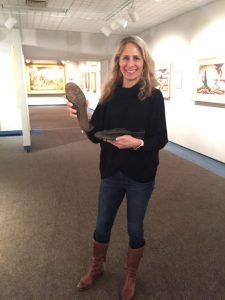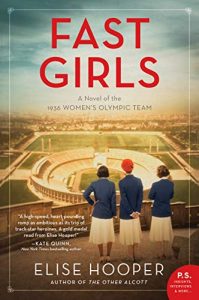Writing Fast Girls
One of the most frequently asked questions I field from readers is “Where do you find your ideas and how do you turn them into books?” Honestly, there’s no special magic fairy dust for this. Having an idea for a story and then turning that idea into a book requires discipline, curiosity, patience, not to mention a steady stream of caffeine, and inspiration tends to come from fairly mundane places—the news, an endnote in a book, a trip to a museum, family lore, and conversations with friends (a good reminder to always be careful what you confess to the writers you know!). In short, I’m always on the lookout for intriguing stories.
Let’s take my newest book, FAST GIRLS as an example.
A few years ago, my younger daughter surprised me with an idea for a book. She was working on a biography project about Gertrude Ederle for her fourth grade class. Ever heard of Ederle? I hadn’t. She was the first woman to swim the English Channel, an amazing feat of endurance and perseverance that took 14 hours and 37 minutes, a time almost two hours faster than the speediest of the five men who had preceded her. She also won three medals in 1924’s Paris Olympics—not bad for a young girl from Brooklyn, right? So why hadn’t I heard of her? Trailblazing athletes like Jackie Robinson and Jesse Owens are household names, but what about the women like Ederle?
I started digging around in history books and the Internet and learned that the fight for women’s participation in amateur and professional sports has been long and controversial. During the first half of the 1900s, many believed competitive athletics inflicted harmful effects upon women—rigorous exercise could damage a woman’s fertility, reduce her feminine curves, and even cause her to develop masculine features such as mustaches, but at the same time, women were demanding the vote, higher education, and wider job possibilities—why not the opportunity to compete in sports?

Elise Hooper holding Helen Stephens’ track shoes
When I came across Betty Robinson, Louise Stokes, and Helen Stephens, track stars of the 1930s whose accomplishments are remarkable but like Ederle’s, largely forgotten, I knew I’d found the subjects of my next book. Out of humble beginning, these three women forged careers as champions and overcame enormous odds to arrive at the 1936 Olympics in Berlin, but like most compelling sports stories, theirs isn’t really about sports—it’s about sisterhood, tenacity, and identity.
Even almost a century later, these themes remain timely as women athletes continue seeking advancement in equal pay, benefits, sponsorship, and professional coaching opportunities.
To research the lives of my main characters, I relied upon several secondary sources, including a few excellent biographies and nonfiction books, but also primary sources like photographs, official Olympic reports, vintage newspaper articles, and oral histories from athletes of the era. Thanks to helpful librarians at several historical societies and archivists at Northwestern University, I was able to look through digitized pages of Betty’s high school yearbooks and college newspaper articles documenting her athletic and social exploits.
While I could accomplish much of my research from the comfort of my office in Seattle, I also decided to visit Missouri to explore where Helen Stephens grew up and visit her private collection of papers and artifacts at the state’s historical society in Columbia. There, I was able to sift through her scrapbooks, photos, and read her hand-written diary of the 1936 Olympics.
While I could find plenty of material on Helen and Betty, the historical record on Louise Stokes is thin and mysterious. In both 1932 and ‘36, Louise had qualified for the Olympics, one of the first African American women to do so, but she didn’t race in either games and I wanted to know why.
A story about her in The Boston Globe from the 1970s shed insight and when I tracked down the reporter who wrote it, he loaned me a huge file of newspaper clippings and interview notes he’d taken with members of the Stokes family.

Elise Hooper standing on the remaining railroad tracks where Louise trained in Malden, MA.
After locating heat-by-heat results from the 1932 Olympic Trials, I determined that Louise’s times were equal or faster than those of the other women in the relay pool, and by pairing this quantitative data with anecdotal evidence from teammates and her family members, I concluded that a combination of racism and sexism on the part of her male coach precluded her from being selected.
As far as her exclusion in 1936, favoritism was the likely reason since the team’s new coach, Dee Boeckmann, had longstanding ties with several other women in the relay pool. These theories represented my best guesses as to what happened and I used them to fill in gaps Louise’s story.
For me, this weaving together of people and places of the past with imagination is a thrilling aspect of writing historical fiction. To hold Helen Stephen’s cracked and beat-up men’s size 12 shoe in my hands allowed me channel how much she was willing to risk to run.
Standing in a busy strip mall parking lot in a Boston suburb and squinting closely to spot remnants of two paved-over steel lines permitted me to imagine Louise’s excitement when she first started training with the Onteora Track Club on what almost a century ago was a rural stretch of the old Saugus Branch Railroad. So, I suppose when I say there’s no special magical fairy dust involved with producing a book, that’s not exactly true. After what feels like millions of hours spent staring glassy-eyed at a computer screen spent researching, writing, and editing, these moments of magic connection with the story make it all worth it.
—
New Englander by birth, Elise now lives with her husband and two young daughters in Seattle.
She’s drawn to historical figures, especially women, who linger in the footnotes of history books yet have fascinating stories waiting to be told.
http://www.elisehooper.com
@elisehooper on Twitter and Instagram
https://www.facebook.com/elisehooperauthor/
FAST GIRLS
 “Fast Girls is a compelling, thrilling look at what it takes to be a female Olympian in pre-war America…Brava to Elise Hooper for bringing these inspiring heroines to the wide audience they so richly deserve.”—Tara Conklin, New York Times bestselling author of The Last Romantics and The House Girl
“Fast Girls is a compelling, thrilling look at what it takes to be a female Olympian in pre-war America…Brava to Elise Hooper for bringing these inspiring heroines to the wide audience they so richly deserve.”—Tara Conklin, New York Times bestselling author of The Last Romantics and The House Girl
Acclaimed author Elise Hooper explores the gripping, real life history of female athletes, members of the first integrated women’s Olympic team, and their journeys to the 1936 summer games in Berlin, Nazi Germany. Perfect for readers who love untold stories of amazing women, such as The Only Woman in the Room, Hidden Figures, and The Lost Girls of Paris.
In the 1928 Olympics, Chicago’s Betty Robinson competes as a member of the first-ever women’s delegation in track and field. Destined for further glory, she returns home feted as America’s Golden Girl until a nearly-fatal airplane crash threatens to end everything.
Outside of Boston, Louise Stokes, one of the few black girls in her town, sees competing as an opportunity to overcome the limitations placed on her. Eager to prove that she has what it takes to be a champion, she risks everything to join the Olympic team.
From Missouri, Helen Stephens, awkward, tomboyish, and poor, is considered an outcast by her schoolmates, but she dreams of escaping the hardships of her farm life through athletic success. Her aspirations appear impossible until a chance encounter changes her life.
These three athletes will join with others to defy society’s expectations of what women can achieve. As tensions bring the United States and Europe closer and closer to the brink of war, Betty, Louise, and Helen must fight for the chance to compete as the fastest women in the world amidst the pomp and pageantry of the Nazi-sponsored 1936 Olympics in Berlin.
BUY HERE
Category: Contemporary Women Writers, How To and Tips























